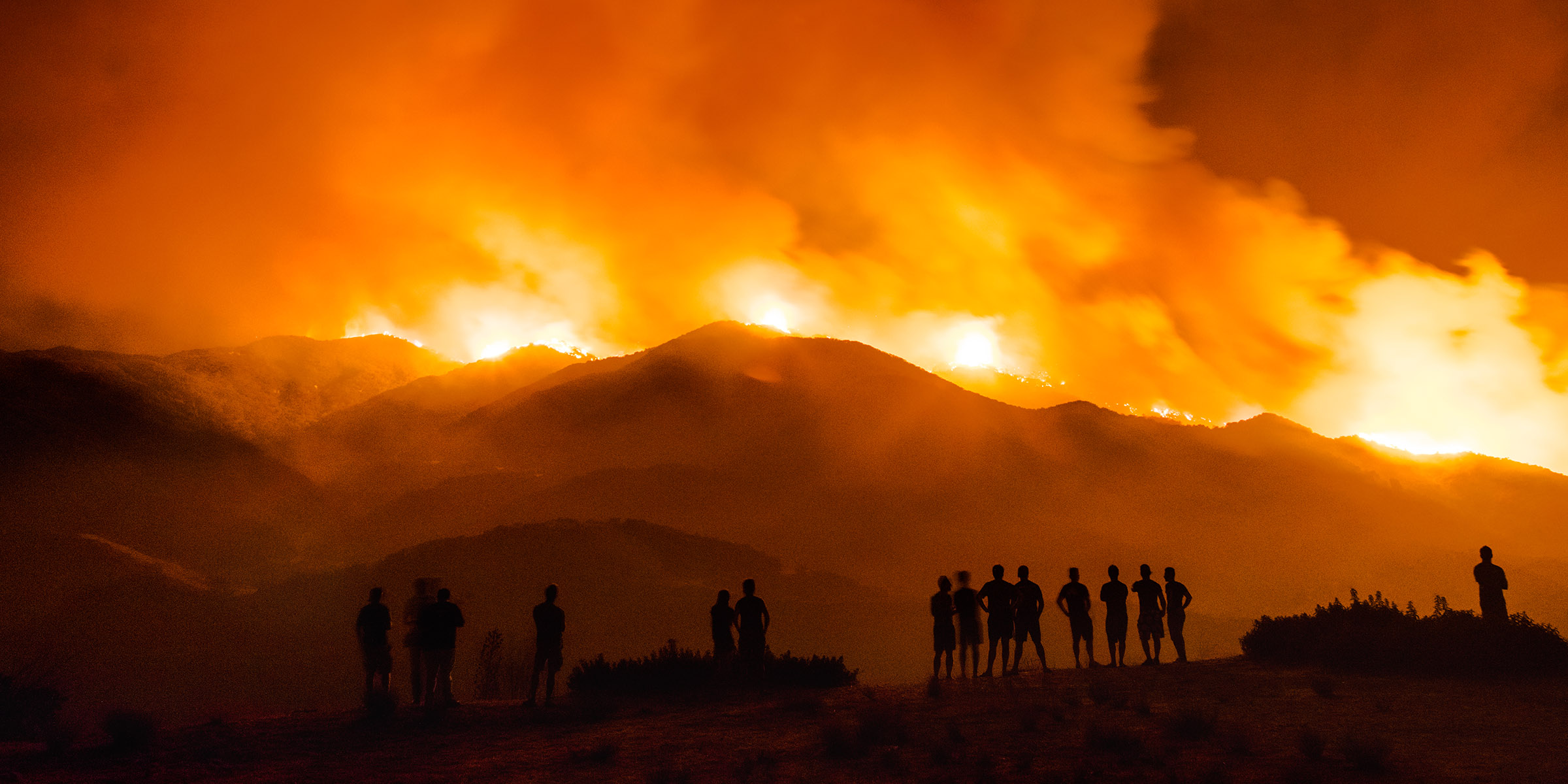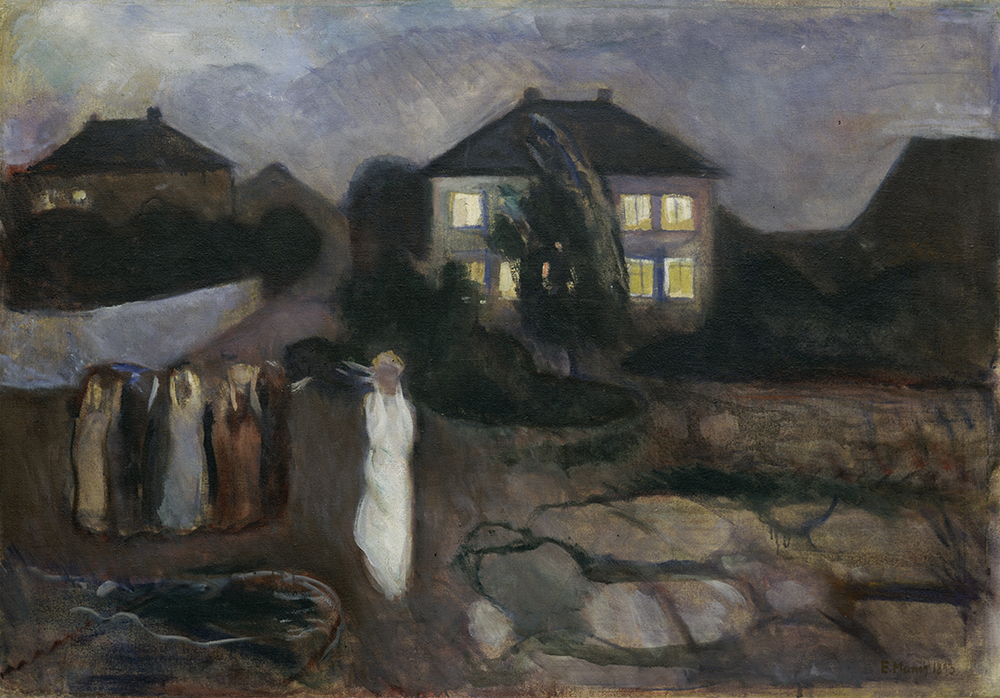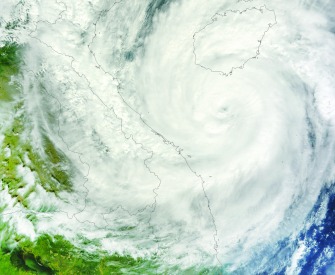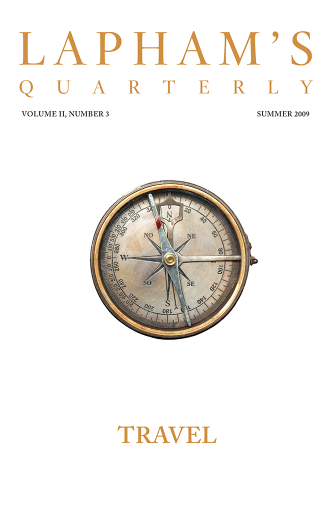When nature is overriden, she takes her revenge.
—Marya Mannes, 1958In the Shadow of Caesar
On the volcanic eruption that set an ominous stage for the death throes of the Roman Republic.
By Kyle Harper

An Eruption of Vesuvius, by Johan Christian Dahl, 1824. The Metropolitan Museum of Art, Gift of Christen Sveaas, in celebration of the Museum's 150th Anniversary, 2019.
Audio brought to you by Curio, a Lapham’s Quarterly partner
The Romans were great believers in omens, and an event as world-shaking as the assassination of Julius Caesar was apportioned its predictable share of signs in the collective memory. The year of his death seemed to start under hopeful auspices. To the Romans, who named their years after the highest officials in the res publica, what we call the year 44 bc was the year when Julius Caesar and Mark Antony were consuls. There are hardly two more eminent names in the annals of Roman history. Julius Caesar was then at the height of his powers, and the award of the consulship to Antony signaled a full reconciliation with his faithful lieutenant after a brief chill. For a moment it must have felt as if there were order in the cosmos. Grand new campaigns of conquest were rumored. But resentment simmered among the old-guard senatorial faction that Caesar had brought to heel. And soon disturbing portents began to appear.
The ancient biographer Suetonius gave a summary catalogue of these signs and warnings. A kingbird (avis regaliolus) was savagely ripped to pieces in the Theater of Pompey. Horses that Caesar had dedicated to the river Rubicon refused to eat and wept instead. A bull sacrificed to the gods was found to be without a heart, and the presiding priest duly warned Caesar that he was in imminent danger. Bad dreams and rumbling heavens followed. Shakespeare, with a dash of poetic license, immortalized these forebodings: “Beware the ides of March.” On March 15, 44 bc, Julius Caesar was hacked to death by his jealous political rivals, plunging the Romans once more into the nightmare of civil war.
On the death of Caesar, even the sun disappeared. And it did not just disappear for a passing moment, as in a normal eclipse. Befitting the demise of the larger-than-life Caesar, the sun absconded for a year. On this point the Roman sources are unusually insistent and coherent. According to Pliny the Elder, writing a century after the fact, “portentous and protracted eclipses of the sun occur, such as the one after the murder of Caesar…which caused almost a whole year’s continuous gloom.” Plutarch was even more vivid in describing “the obscuration of the sun’s rays”:
During all that year its orb rose pale and without radiance, while the heat that came down from it was slight and ineffectual, so that the air in its circulation was dark and heavy owing to the feebleness of the warmth that penetrated it, and the fruits, imperfect and half-ripe, withered away and shriveled up on account of the coldness of the atmosphere.
It is easy enough to dismiss these observations as the superstitions of a prescientific age. We might attribute them to the human mind’s infinite ability to imagine connections where there are none, or more generously, we could try to understand these reports as culturally meaningful texts, a symbolic language through which the Romans experienced the world. But thanks to unexpected insights and data gained from our own urgent need to understand the earth’s climate, we have learned that there is much more to the story of the celestial signs that followed Caesar’s death.
In the August 1983 issue of the Journal of Geophysical Research, two scientists from NASA’s Goddard Institute for Space Studies, Richard Stothers and Michael Rampino, published one of the most remarkable pieces of interdisciplinary history ever written: “Volcanic Eruptions in the Mediterranean Before ad 630 from Written and Archaeological Sources.” Their project of assembling a catalogue of historic earth events was nothing revolutionary in itself; Stothers and Rampino built on centuries of work by geologists to collect references in the literary record. But what made their contribution so thrilling was their insight that many ancient reports of volcanic eruptions and other atmospheric anomalies could be correlated with a new kind of historical evidence: ice cores from Greenland.
The progressive buildup of knowledge about how the climate system works has been painstakingly achieved by the collective and incremental enterprise of earth science. Paleoclimatology is an integral part of this enterprise, and there is no understanding where the climate is going without understanding where it has been. And ice cores are one of the most important records of the past climate. These sleek columns hoisted from the ice sheets are a kind of natural archive: frozen texts written in the language of geochemistry.
Even though human-driven climate change has pushed us to the edge of a perilous new epoch known as the Anthropocene, the earth’s climate has always varied and changed. Though this fact is often gleefully trotted out by climate-change skeptics, in reality our understanding of the present peril is framed and sharpened by our knowledge of the climate’s turbulent past. The causes of natural climate change are many. Gradual oscillations in the tilt, spin, and orbit of the earth change the amount and distribution of solar energy reaching the surface of the planet. The sun itself is an inconstant star; the eleven-year sunspot cycle is only one familiar example of its variability. But among the natural causes of climate forcing, volcanoes hold a special place. Nothing else can trigger such short-term and violent climate anomalies. And almost nothing leaves such a distinct and potentially decipherable time stamp on the ice records.
Large volcanic eruptions inject massive amounts of sulfur dioxide into the stratosphere. While heavier ash particles fall quickly back to earth, sulfur gas is aerosolized. The fine suspensions stay aloft in the stratosphere for years. Diffused by the stratospheric jet stream, they can unfurl across one or both hemispheres, depending on the location and timing of the volcanic eruption. This veil of sulfate aerosols scatters solar energy, causing rapid cooling. If carbon dioxide is like a blanket that holds in the earth’s heat, volcanic sulfur aerosols are like the foil reflector you put behind your car’s windshield. The effects can last for years, but eventually gravity wins and pulls the particles down. Some of the volcanic ejecta ends up falling in the snow that settles quietly on Greenland’s ice sheets, where it is packed in annual layers that record the history of the earth’s atmosphere.
The 1983 study appeared in the early days of paleoclimatology, but even then Stothers and Rampino noted that the historical records aligned with “the presence in Greenland ice cores of marked acidity peaks.” Earth science and the science of the human past drew a little closer together. Reports of solar dimming and celestial phenomena that had been hard to take seriously could now be cross-checked with a physical record, and human observations from the distant past provided a remarkable validation of the chemical archive.

La Tuna Canyon Fire, by Kevin Cooley, 2017. Archival pigment print, 30 x 38½ and 40 x 51½ inches. A crowd gathers in the Los Angeles neighborhood of Tujunga to watch the La Tuna Canyon fire burn in the Verdugo Mountains north of Burbank. © Kevin Cooley, courtesy the artist and Kopeikin Gallery, Los Angeles.
When knowledge crosses disciplines, even the familiar can take on a new appearance. For example, before Stothers and Rampino, ancient historians had managed to ignore completely the evidence for a significant planetary event in 536. A wide range of sources testify that the sun was dimmed for fifteen months starting that spring. One of the most violent sequences of environmental shock in the recent history of our species began with a large eruption in the Northern Hemisphere, probably caused by a volcano in Iceland. It was followed by an even larger tropical eruption in 540. These volcanic explosions ushered in the single coldest decade of the past several thousand years. In some interconnected way that is still not completely understood, the very next year saw the outbreak of the first pandemic of bubonic plague, at the time the most lethal biological event in human history.
A decade after the NASA scientists laid out the evidence for an eruption in 44 bc, the classicist Peter Bicknell made a startling observation. Unlike chemical analysis of ice cores, this observation derived from the most traditional kind of historical investigation, although Bicknell was deeply informed by the climate science, too. Annalistic sources for Han dynasty China recorded a series of solar anomalies in 44 bc and terrible harvests for three years afterward. One imperial edict declared,
We have been trembling and in respectful awe, day and night thinking of our faults and defects, and have not dared to be negligent or at peace. We have pondered that the yin and yang have not been harmonized, and we have not yet secured enlightenment concerning what is to blame…For this reason, evil emanations have yearly increased and have encroached upon and violated the great yang [the sun], so that good emanations have been submerged and arrested, and the sun for a long time has been robbed of his light.
Another proclaimed,
Recently for consecutive years, the harvest has not been gathered, and the four quarters of the empire are all suffering. The great multitude of common people work hard at plowing and weeding, but it does not produce any results, so that they suffer from a famine of grain and vegetables, and there is no means by which they can be saved. We are the father and mother of the people, but our virtue is not able to protect them.
The Chinese were, of course, oblivious to the death of Julius Caesar, although it was in this period that the far eastern and western ends of Eurasia became meaningfully aware of each other. The Romans knew of “the silk people” at the far edge of the inhabited world, and the Chinese in turn had learned of a shadowy Da Qin, or Great China, far beyond the Middle Kingdom. The Chinese observations of atmospheric anomalies and harvest failures belonged to a cultural framework completely different from that of the Romans; it was the world of yin and yang, of an empire legitimated by the Mandate of Heaven. The total independence of the Chinese evidence suggests that the event of 44 bc spanned at least half the globe.
The correlation that Stothers and Rampino observed in the chemistry of the Greenland ice was still very loose. They noted a peak of sulfuric acid in 50 bc, plus or minus thirty years—hardly pinpoint accuracy. And they suggested that the volcano responsible for the eruption was Mount Etna in Sicily. The machines and methods of earth scientists have advanced and multiplied since their study. It is increasingly possible to retrieve high-resolution, seasonal-scale climate data stretching thousands of years into the past, and the climate models are ever more sophisticated. The number of natural proxies now turned into climate records is a testament to human genius. In addition to ice, lake sediments, stalagmites, pollens, corals, and tree rings have been tapped as climate archives. It has become possible to refine both the chronology and the geography of the climatic event that followed the death of Julius Caesar.
If ice cores are a refrigerated chemical archive of the past climate, trees and their annual growth rings are organic records of how living things responded to changes in temperature and precipitation. Trees that are particularly sensitive to one climate variable or another can furnish paleoclimate archives of exceptionally precise chronological resolution. There is something eerily beautiful about the dendrochronological record, the passing of centuries written so visibly and so minutely in the annual growth rings.
Tree-ring records can register the climatic effects induced by volcanoes in different ways from ice cores. A bitterly cold year or a dry spring can stress the tree and inhibit growth. There is good alignment between tree-ring records and written accounts of frigid years likely induced by volcanic cooling, but for a long time there was a frustrating lack of calibration between the ice cores and tree rings. In the past few years, thanks to more data and some clever puzzle solving, the paleoclimate records have begun to be reconciled. Ice cores and tree rings now speak in greater unison about the history of the earth’s environment in the Holocene epoch, and it is clear that a major event in planetary history transpired in 44 bc.
This greater coherence between the records has made it unlikely that Mount Etna was primarily responsible for the cooling in the year of Caesar’s death. Towering over Sicily, Etna is one of the Mediterranean’s great volcanoes; according to legend, the forges of the god Hephaestus lay underneath its smoldering caldera. It is an extremely active volcano, and there is written evidence for an eruption in 44 bc. One Roman historian noted that Etna erupted before the death of Caesar, spewing balls of fire as far as Rhegium on the mainland across the Strait of Messina. It is not unreasonable to hypothesize that the eruption of Etna, the sulfur in the Greenland ice, and the attested climate impacts were all connected.
One problem with the Etna theory, though, is that the volcano is not known to have caused eruptions in the recent past that trigger the kind of large-scale climate-forcing events that would induce devastating famines on opposite ends of Eurasia simultaneously. Moreover, evidence from Southern Hemisphere ice cores makes the Etna hypothesis less likely. When volcanoes in the temperate or high latitudes of the Northern Hemisphere inject sulfates into the stratosphere, circulation patterns will disperse the aerosols across the Northern Hemisphere. The 44 bc event seems to have left traces of sulfate peaks in both Greenland and Antarctic ice cores (though the chronology of the ice record from Antarctica is still being worked out), a good indication that the responsible volcano lies somewhere in the equatorial zone. While Mount Etna may well have rumbled on the eve of Caesar’s death, it was probably a tropical volcano larger than Etna that sometime later that year dimmed the sun, cooled the planet, and shriveled crops.
It seems to me that we all look at nature too much and live with her too little.
—Oscar Wilde, 1897At present we do not know with certainty which of the earth’s volcanoes caused the events of 44 bc. Suspicion has fallen on Apoyeque in western Nicaragua, a kind of volcano known as a pyroclastic shield. Today Apoyeque’s deep crater is filled with a lake nearly 1.75 miles across and a quarter-mile deep. The massive explosion that left Apoyeque as we see it now is thought to have occurred around two thousand years ago. The timing, geography, and scale all seem to fit with what we know of the 44 bc eruption. But this, too, is speculative, and until tephra analysis—a kind of chemical fingerprint for a volcano—matches the traces left in the ice cores with Apoyeque, it will remain no more than a hypothesis.
Still, it is moving to imagine that what is today a serene tropical lake in central America might be the geological remnant of an event that rattled societies from Rome to China.
The ice cores and tree rings have one more thing to say about that fateful year. The eruption of 44 bc was a historic event. A study published in Nature in 2015 that synthesized ice cores from both hemispheres as well as tree-ring data ranked it as the third-largest eruption on the planet in the past 2,500 years. If measured by the growth of bristlecone pine trees in the western United States, it registers as one of the most powerful climate-forcing events of the last several millennia, more consequential than the 1815 Tambora eruption. Tambora caused the “Year Without a Summer” and triggered harvest failures and misery across the globe. The first global cholera pandemic followed in its wake, and its cultural ramifications were manifold. (Shut indoors throughout a dreary summer on Lake Geneva, Mary Shelley wrote Frankenstein.) If the event of 44 bc was even in the same league, its reverberations were likely just as profound.
In 2017 a careful study established that the record of volcanic eruptions aligned with episodes of social violence in Egypt under the Ptolemies, the Greek dynasty that ruled the kingdom of Egypt from the death of Alexander the Great until the coming of the Romans. Climate change on various scales has been an intimate and enduring part of human history. Yet coupled human-natural systems are stunningly complex, and our understanding of them is far from settled, particularly when it comes to single events rather than deeper patterns. Did the signs from the sky and the trauma of environmental shock—experienced as miserable deprivation and unaccountable suffering—contribute to the religious aura that came to surround Caesar’s successor Octavian, who in 27 bc adopted the title Augustus? Did exhausting famine and pestilence frame the decisive military conflict between republicanism and Caesarism? How did the Nile’s failure play into the ultimate demise of the Ptolemaic regime? It is still much easier to ask such questions than to answer them.
Historians have had no trouble explaining the fallout from Caesar’s assassination without resort to any environmental factors. It is an inconvenient intrusion to learn that, after all, the heavens were active in the momentous events of 44 bc. Yet we need to reimagine that decade unfolding against the backdrop of one of the most explosive volcanic eruptions in the later Holocene. Traditional sources can help point the way. Ancient witnesses testify to the experience of pestilence and famine in the years immediately following the disappearance of the sun. As the advent of bubonic plague in 541 and cholera in 1816 both attest, one of the side effects of volcanic cooling is epidemic disease. The links between the climate system and human health are many, complex, and unpredictable. But they are also strong. Human societies are embedded in their physical environment. So, too, are the populations of rats, flies, mosquitoes, and other creatures that are important hosts or vectors of infectious diseases. Food shortages can weaken the human body, depleting the immune system and making us easier prey for microbial pathogens. Hunger can stir urban crowding or subsistence migration that facilitates disease transmission. Climate variability can induce sudden population explosions of mosquitoes carrying diseases like malaria. In short, climate shocks and health catastrophes have always gone hand in hand.

The Storm, by Edvard Munch, 1893. Digital image © The Museum of Modern Art / Licensed by SCALA / Art Resource, NY.
The most evident impact of sudden global cooling was crop failure. Ancient societies were fundamentally agrarian and poor. For all the visible remains of Roman splendor, we must not forget that the Romans ruled over an essentially underdeveloped society or congeries of societies. Per capita annual income in the Roman world was well below a thousand dollars. People lived close to the land, perpetually on the edges of subsistence. The Mediterranean climate was fickle to begin with, and without the summer sun, crops withered and harvests failed.
By the late republican period, the Romans already had come to depend on Egyptian grain as a source of their food supply. Egypt was the breadbasket of the Mediterranean. Its ecology is unique. The Nile River cuts a green valley through the middle of a harsh desert. The annual Nile inundation begins in the highlands of Ethiopia, where summer monsoon rains drench the hills and run off into the Blue Nile. Egyptians had learned over millennia to live in intimate dependence upon the annual flood, diverting and controlling it through an intricate irrigation system that supplied one of the most miraculously fertile plains on earth. The Egyptians treated the river with religious reverence, keenly aware of its unpredictable moods, though oblivious to the real causes of its fickle nature. The El Niño–Southern Oscillation, one of the most powerful modes of natural climate variability, had a profound influence on the Nile flood regime. Volcanic cooling shifts the monsoons to the south and triggers drought in regions that normally depend on the summer rains. Thanks to global climate mechanisms, large volcanoes spell serious trouble for the most reliable agriculture region in the Mediterranean.
It is not coincidental that the last of the Ptolemaic line was Cleopatra, lover of both Caesar and Antony (sequentially, not simultaneously). She was in Rome at the beginning of that year, though by summer she had returned to Egypt. Historical documents suggest that the Nile flood failed in successive years, 43 and 42 bc. Such a double blow thinned the grain reserves and then induced a crisis. Cleopatra opened the royal granaries, but hunger and pestilence ravaged the country.
The complex political events following the assassination of Caesar unraveled amid these environmental challenges. At first Caesar’s young heir, Octavian, and his chief lieutenant, Mark Antony, fought for the mantle of the Caesarian faction. But they were able to form an uneasy alliance in order to marshal their united power against the formidable senatorial faction that had killed Caesar and fled to the east. The conflict finally came in 42 bc, in a pair of battles in quick succession outside of Philippi in northern Greece. The ancient histories insist that the armies had suffered through cold, sickly, and hungry seasons by the time they met. What ensued was one of the bloodiest, most brutal encounters in Roman history, and also one of the most decisive. In the end, the senatorial armies were routed. The future of Caesarism was secured on the plains of Greece, as the wider world suffered the wrenching aftermath of the sun’s disappearance.
It was Octavian who was ultimately destined to inherit the legacy of Caesarism as Augustus. But in the 40s bc, he was still very much the junior partner, too sick to appear on the battlefield at Philippi. He returned to the west, where he methodically built his base of power in the shadow of his adoptive father, now worshipped as a demigod whose ascent to divinity was affirmed by the heavens themselves. Meanwhile, Mark Antony became the master of the eastern Mediterranean. In a letter written to the ruler of Judea—the immediate predecessor of Herod the Great, and already a Roman puppet—Antony cast the victory of Caesar’s party over the assassins in cosmic terms that connected his triumph with the events foretold by the heavens. “It was not only our own battle but that of all mankind in common that we fought when we avenged ourselves on those who were guilty both of lawless deeds against men and of unlawful acts against the gods, from which we believe the very sun turned away, as if it, too, were loath to look upon the foul deed against Caesar.”
Soon, like Caesar before him, Antony was entangled in a romantic and political partnership with the queen of Egypt. They were, in history and in legend, a formidable pair. In Roman tradition, the failure of the Nile in two successive years was remembered as an omen of their double failure as regents in the East. Shakespeare’s version of the future Augustus was gracious in victory: “The death of Antony / Is not a single doom, in the name lay / A moiety of the world.” The heavens smiled on Augustus. Nature itself seemed to welcome the arrival of the Pax Romana. As the ice cores confirm, even the volcanoes lay quiet for the whole of his long and charmed reign.

This story is part of Covering Climate Now, a global collaboration of more than 300 news outlets to strengthen coverage of the climate story.


